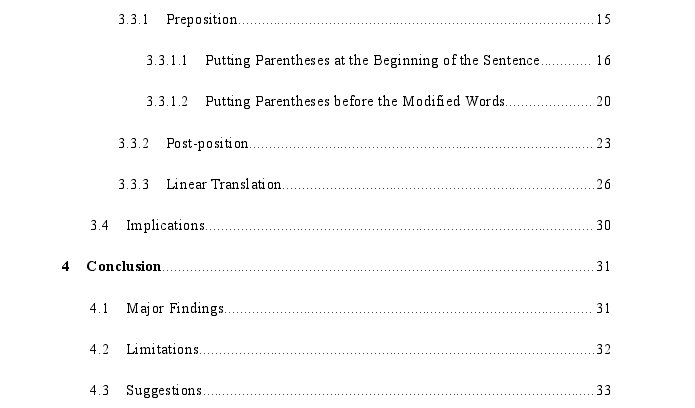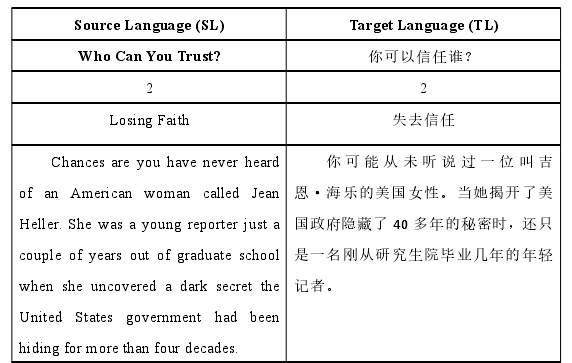英语论文哪里有?笔者认为一般来说,在翻译括号时,应根据其功能、语境等因素选择合适的翻译方法,以符合目的语的表达习惯。因此,了解原文的整体内容和结构有助于保证译文的质量。
1 Task Description
1.1 Background of the Task
An irresistible trend in today’s society is that the development of science andtechnology not only promotes the emergence and development of “sharing economy”and “cooperative consumption”, but also greatly changes the trust model in our life.The book Who Can You Trust? describes the development process of different trustmodels and its impact on human society so that it will be a good choice for readerswho want to gain a deeper comprehension of trust. In the meantime, one of the mostprominent characteristics of this text is that the author puts some information asparentheses in the sentence. In this way, the difficulty of understanding caused by thecomplexity of sentence structure is avoided.
As one of the important characteristics of English, parentheses always interruptthe coherence of both sentences and their meaning, and thus may be of greatchallenge to the translator. And since parentheses are syntactic component that cannotbe ignored or removed, the translator must consider comprehensively and translatestrategically, otherwise it is possible to sink into the mire of translationese. Therefore,in order to further study and analyze the translation methods of different types of parentheses, translator collects, classifies and analyzes the parentheses in the sourcetext, hoping to provide some reference for the translation of parentheses.

2 Process Description
2.1 Preparation before Translation
Before translating, much preparatory work should be done to guarantee theaccuracy of the translation. The very first step of preparation is to gain a completeunderstanding of the overall structure, characteristics and writing style of the bookthrough reading the whole book roughly. As an indispensable part of the translationpractice, this step is helpful for deepening the understanding of the source text.
The next step is about information collection. In the source text, many casesquoted by the author are closely related to many news events, which are real and havea profound impact on society. Therefore, it is necessary for the translator to researchand learn news reports related to this book in advance to guarantee the authenticityand objectivity of the translation. In addition, the translator also needs to accumulateproper nouns that appear in the book during this process, which is very useful for latertranslation.
3 Case Analysis
3.1 Theoretical Framework
With a view to having an in-depth analysis of these translation materials guidedby Communicative Translation, the translator will review relevant theoretical worksand publications concerning Peter Newmark’s translation theory, CommunicativeTranslation in particular. Through reviewing previous researches, it is fair to state thatthis theory can be applied to guide the author’s report.
3.1.1 Brief Introduction to Communicative Translation Theory
In Approaches to Translation, Newmark, a well-known translation theorist andlinguist, proposed the Semantic Translation and the Communicative Translation basedon years of translation experience. Newmark (1981) defines CommunicativeTranslation as trying to produce an effect on its target language readers as equivalentas possible to that gained on the readers of the source language (p. 39). Semantic translation “ attempts to render, as closely as the syntactic and semantic structures ofthe source text allow, the exact contextual meaning of the original” (Newmark, 1981,p. 39).
In a real case, when it comes to Communicative Translation, it is alwaysaccompanied by Semantic Translation, both of them have connection and differences.Shuttleworth and Cowie (2004) explains that Communicative Translation concentrateson the purpose of conveying the information of the original language, which is in linewith the linguistic and cultural custom of the target language, and SemanticTranslation emphasizes on the reproduction of the form of the original language (p.21). As a consequence, Semantic Translation points out that the translator has theresponsibility to highlight the role of the writer of the source text by remaining asmuch of the syntactic and semantic structure of the source text as possible. WhileCommunicative Translation endows the translator with the right to modify certain partof the original text, so that the translation can be smoother, more idiomatic andreadable (Newmark, 1998b, p. 47). It emphasizes the role of the translator inproducing as an equivalent effect on the target reader as possible by focusing itselfsolely on readers in the target language, which can make it smoother, more idiomaticand readable so as to better serve the function of communication in translation. That isto say, compared with Semantic Translation, which only serves one single person,namely the author of the source text, Communicative Translation focuses on themessage of the source text as well as serving a larger reader group.

3.2 Classification of Parentheses
Prior to analyzing the parentheses in the source text, the translator should firsthave an accurate understanding of what the classification of parentheses is. Thischapter mainly presents various definitions, classification of parentheses andintroduces the classification method adopted in this report in detail.
In Oxford Dictionary of English, parenthesis is defined as “a word, clause, orsentence inserted as an explanation or afterthought into a passage that isgrammatically complete without it, in writing usually marked off by curved brackets,dashes, or commas”. And Corder mentions that parenthesis is “a qualifying,explanatory, or appositive word, phrase, clause, or sentence occurring within asentence in such a way as to form an interpolation independent of the surroundingsyntactical structure”, which mainly focuses on the function of parenthesis (Corder,1962, p. 136). In the meantime, He Ziran also point out that as an independentcomponent in the sentence, parentheses have cancellability on the structure, whichhave no impact on the sentence structure after being removed (He, 2006, p. 28).
4 Conclusion
4.1 Major Findings
This practice report focuses on the translation methods in dealing with theparentheses in the informative text Who Can You Trust? under the guidance of PeterNewmark’s Communicative Translation. In this report, many typical examples arequoted to analyze and summarize the translation of parentheses. It offers its answersto the two research questions that the report focuses on at the very beginning: “whatare the difficulties in translating the selected text?” and “what are the strategies intranslating parentheses in the selected text?”.
Specifically, according to Ding Wangdao’s classification method for parentheses,the author classifies the parentheses contained in the source text into three types,including parentheses as an adverbial, attributive and appositive.
After calculating and analyzing the translation methods selected to render theparentheses in the source text, the translator finds that the frequency of these fourmethods is the highest in translation practice, including pre-position (putting the parentheses at the front and putting the parentheses before the modified word),post-position and linear translation. Firstly, because the semantic center of Chinese issituated at the end of the sentence, when the content of parentheses is closely relatedto the whole sentence, parentheses can be moved before sentence. Secondly, if thestructure of parentheses is relatively short and simple, it can be put before themodified words according to the expression of Chinese. Thirdly, different fromputting parentheses before the modified words, postposition means that whenparentheses are long and complex, the translator can render it into a separate sentenceif the parentheses have a closer relationship with the modified word than to the wholesentence. With this method, the logic contained in this informative text can beexpressed more clearly. Fourthly, because the sentence and grammatical structure ofsome sentences containing parentheses is basically consistent with Chinese, thetranslator does not choose to reconstruct the sentence structure, but render it in linewith the order of the source text.
reference(omitted)

